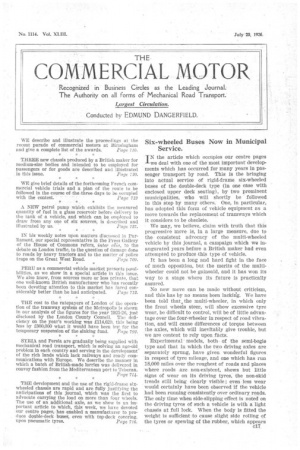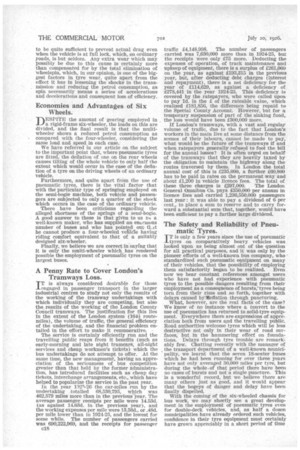Six-wheeled Buses Now in Municipal Service.
Page 1

Page 2

If you've noticed an error in this article please click here to report it so we can fix it.
IN the article which occupies our centre pages we deal with one of the most important developments which has occurred for many years in passenger transport by road. This is the bringing Into actual service of rigid-frame six-wheeled buses of the double-deck type (in one case with enclosed upper deck seating), by two prominent municipalities, who will shortly be followed in this step by many others. One, in particular, has adopted this form of vehicle equipment as a move towards the replacement of tramways which it considers to be obsolete.
We may, we believe, claim with truth that this progressive move is, in a large measure, due to the consistent advocacy of the multi-wheeled vehicle by this journal, a campaign which we inaugurated years before a British maker had even attempted to produce this type of vehicle.
It has been a long and hard fight in the face of much opposition, but the merits of the multiwheeler could not be gainsaid, and it has won its way to a stage where its future is practically assured.
No new move can be made without criticism, and this has by no means been lacking. We have been told that,, the multi-wheeler, in which only the front wheels steer, will show excessive tyre wear, be difficult to control, will be of little advantage over the four-wheeler in respect of road vibration, and will cause differences of torque between he axles, which will inevitably give trouble, but we are content to rely upon facts.
Experimentalmodels, both, of the semi-bogie type and that in which the two driving axles are separately sprung, have given wonderful figures in respect of tyre mileage, and one which has run 18,000 miles over the roughest of roads and places where roads are non-existent, shows but little signs of wear on its driving tyres, the non-skid treads still being clearly visible; even less wear would certainly have been observed if the vehicle had been running consistently over ordinary roads. The only time when side-slipping effect is noted on the driving tyres of such a vehicle is with a light chassis at full lock. When the body is fitted the weight is sufficient to cause slight side rolling of the tyres or spewing of the rubber, which appears to be quite sufficient to prevent actual drag even when the vehicle is at full lock, which, on ordinary roads, is but seldom. Any extra wear which may possibly be due to this cause is certainly more than compensated for by the total elimination of wheelspin, which, in our opinion, is one of the biggest factors in tyre wear, quite apart from the effect it has in lessening the shocks in the transmission and reducing the petrol consumption, as spin necessarily means a series of accelerations and decelerations and consequent loss of efficiency.






























